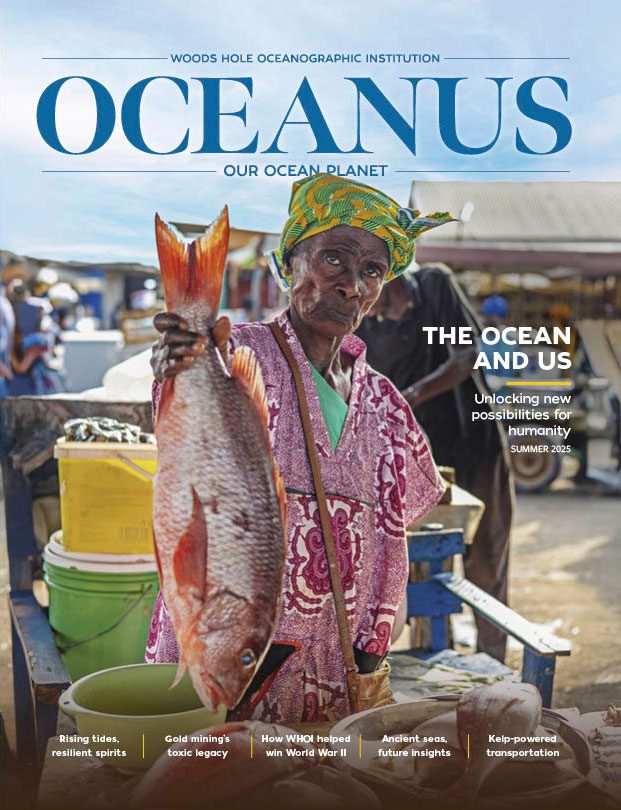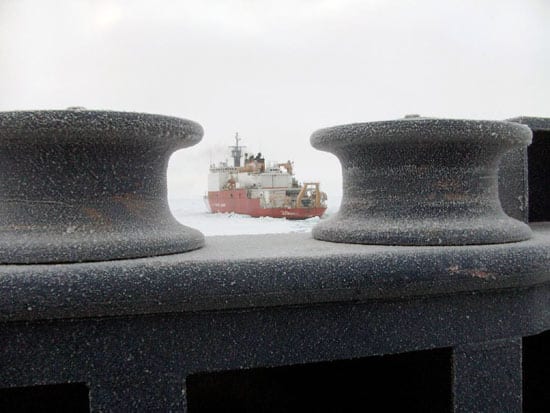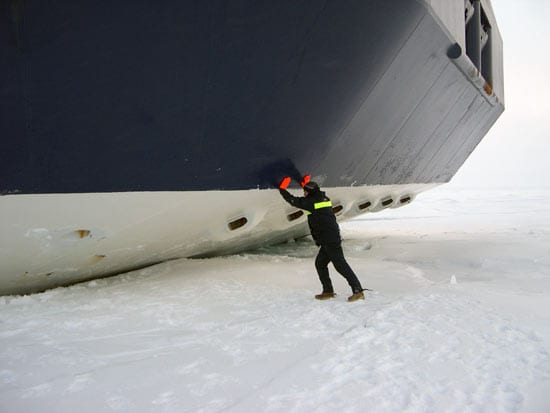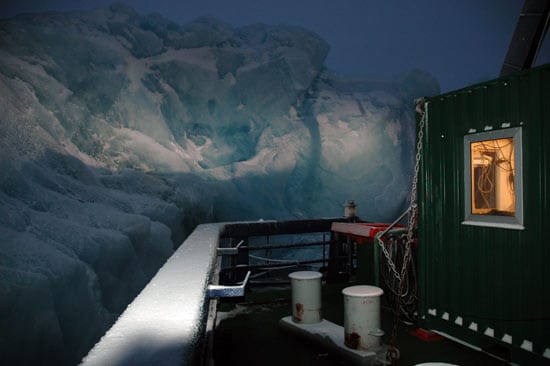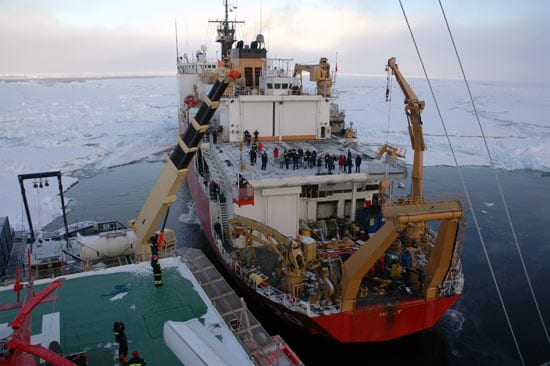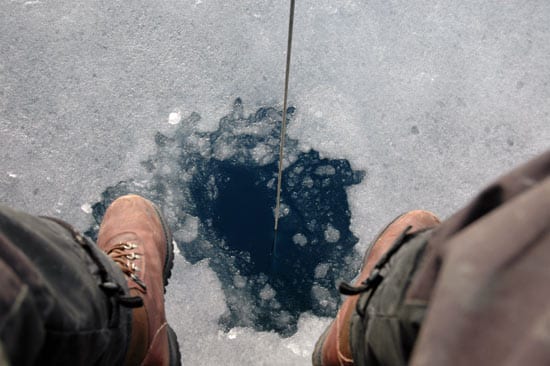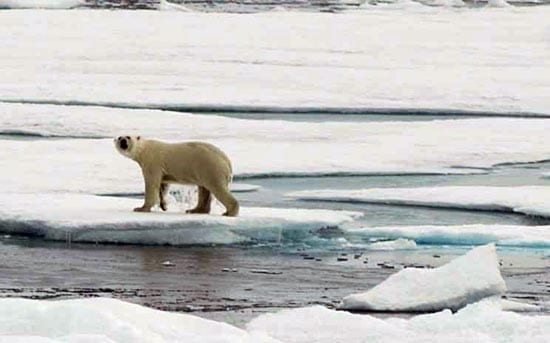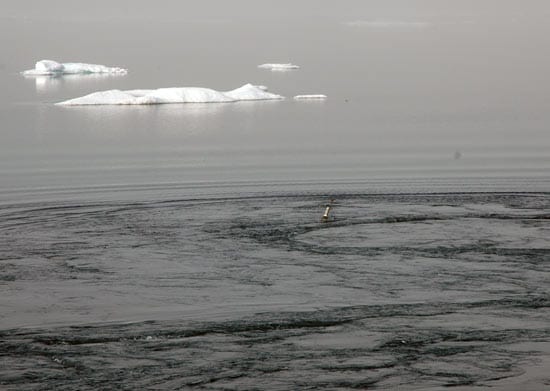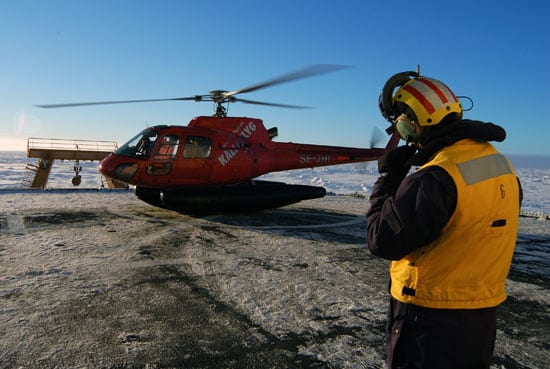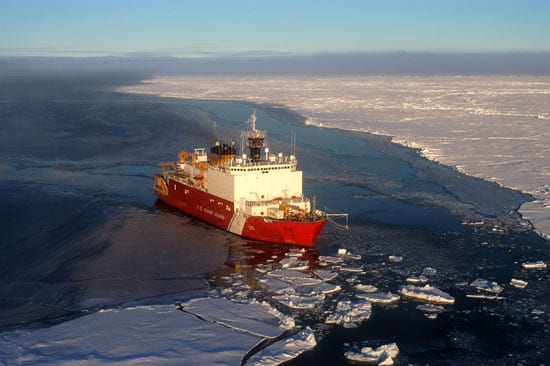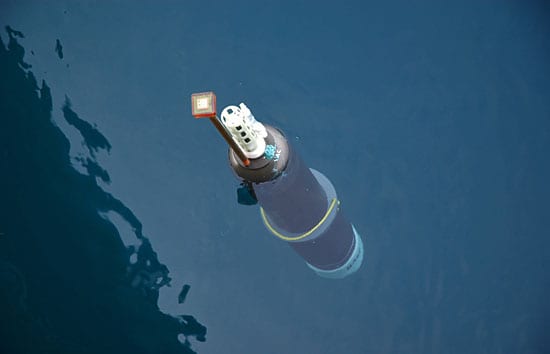
Under-ice Floats Offer a ‘Breakthrough’
New instrument proves its mettle in an icy ocean
The Arctic Ocean, home to fierce winds, punishing temperatures, and thick sea ice, is no place for wimpy people—or machines. So when WHOI physical oceanographers Peter Winsor and Breck Owens set out to explore the largely unknown currents beneath the polar sea ice, they had to design an instrument with true grit.
“We needed the ultimate Arctic machine: intelligent, tough, and durable,” Winsor said.
In recent years, oceanographers have employed torpedo-shaped instruments called floats that drift, nose pointed up, at various depths through the oceans while measuring water temperature and salinity. The floats are programmed to rise to the surface periodically and send data via satellite antenna to scientists on shore.
More than 2,000 of these floats are now dispersed to collect data over wide swaths of ocean territory for many years. Similar floats could work beneath the ice, but scientists have struggled to figure out how the floats would surface in ice-covered waters to transmit data.
A hard-headed instrument
Over the years, Owens has seen several proposals to overcome this barrier. They have included systems to give floats the capacity to melt ice, or devices that reflect sound signals off ice.
“But there are just too many things that can go wrong with complex designs,” Owens said. “Our mantra was: the simpler, the better.”
The floats he, Winsor, and WHOI engineers developed are smooth-sided and free of external machinery that could snag on ice. Next the scientists added toughness—particularly in the antenna, which is made of hard polyurethane that can withstand repeated impacts against the hard underside of sea ice.
Finally, they incorporated the “intelligence.” When the float rises and encounters ice, it is programmed to simply sink to a shallow depth and try again (and again, up to 100 times). Eventually it rises in an ice-free area, or in narrow cracks called leads between sea ice.
“Bounce, bounce, bounce—the float antenna knocks against the underside of the ice,” Winsor said. “It knows it should go back down, wait awhile, then test again for open water.”
A gift from the North Pole
This summer, Winsor deployed three experimental floats into ice-clogged waters during a seven-week voyage across the Arctic Ocean aboard the Swedish icebreaker Oden. Though the floats were launched simply to see if they would work, Winsor is basking in their apparent success.
“It’s like Christmas,” Winsor said in mid-November, one day after the third float he deployed in heavy ice near the North Pole finally communicated with WHOI scientists. “It told us, in its own float language, ‘Here I am, and here’s the data I’ve collected so far.’ ”
As winter sea ice thickens, the floats—as expected—are communicating less often (“two have been quiet,” he said. “Probably taking a well-deserved break”). But weekly reports continue from a third float now being carried by inflowing Atlantic water into a large undersea canyon called St. Anna Trough, located between Svalbard (north of mainland Europe) and Franz Josef Land (north of Russia).
“The float seems to have found a streak of open water and is doing great,” Winsor said.
He expects that the float will circulate around this huge trough, and in the months ahead make it out again into the Nansen Basin, north of Greenland.
Future floats
Winsor and Owens are now working on proposals that could eventually seed the Arctic with floats. “Imagine what we could learn if we could have many of these roaming around the Arctic Ocean,” said Winsor, who is a WHOI Ocean and Climate Change Institute fellow.
Additionally, they want to tweak their technology to include, for example, two-way communications that would give scientists the ability to modify the floats’ missions from shore.
Winsor said the floats won’t replace scientists on icebreakers visiting the Arctic, but will allow year-round research in a remote region where for months on end it is simply “too dark, too icy, too dangerous, and too cold” for even the toughest scientists.
“We joke that we’ve developed these floats because we’re just jealous of oceanographers who work in the tropics,” he said. “We say our ultimate dream is to create something that lets us sit on the beach with our laptops and collect data while the Arctic snow flies.”
The National Science Foundation’s Office of Polar Programs funded this research.
From the Series
Slideshow
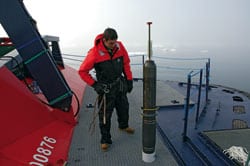
Slideshow
- WHOI scientist Luc Rainville, on the Swedish icebreaker Oden in August 2005, prepares to test an experimental float designed for under-ice operations in the Arctic. (Photo by Peter Winsor, WHOI)
- Scientists and crew aboard the Swedish icebreaker Oden search for narrow cracks in the ice, called leads. Traveling through leads makes navigation easier. (Photo by Peter Winsor, WHOI)
- The U.S. Coast Guard icebreaker Healy was photographed from the deck of the research vessel Oden. The vessels worked in tandem to break through Arctic ice. (Photo by Bob Newton, Lamont-Doherty Earth Observatory )
- WHOI scientist Luc Rainville "supports" the bow of the icebreaker Oden during a half-day stop at the North Pole, midway through the expedition. Icebreakers often ride atop sea ice and come down on it to smash open passages. (Photo by Peter Winsor, WHOI)
- Ship lights illuminate an iceberg near the fantail while the vessel was stopped for research. (Photo by Peter Winsor, WHOI)
- Scientists and crew from the two icebreakers held meetings to coordinate operations. Here a crane transports scientists between icebreakers to hold a meeting. Most days, though, they shuttled by helicopter. (Photo by Peter Winsor, WHOI)
- WHOI scientist Peter Winsor takes a break from a snowball fight during a stop to sample ice. "Below my feet were three meters of ice and 4,000 meters of sea water," he said. (Photo by Luc Rainville, WHOI)
- WHOI scientist Peter Winsor peers into a hole cut into the ice to deploy an instrument into the ocean underneath. "It was nice hanging out there, on the ship's fantail, with ice stretched as far as I could see," he said. "I felt alone in the Arctic." (Photo by Peter Winsor, WHOI)
- This soggy polar bear was one of 16 that scientists spotted in a single day. "He was running along the side of the ship, swimming between ice floes," he said. (Photo by Peter Winsor, WHOI)
- These torpedo-shaped instruments, called polar profiling floats, drift nose-up at various depths through the Arctic Ocean while measuring water temperature and salinity. The floats are programmed to rise to the surface periodically and send data via satellite antenna to scientists on shore. (Photo by Peter Winsor, WHOI)
- On the third or fourth day of the expedition, scientist Peter Winsor deployed the first of three polar profiling floats in a relatively ice-free area north of Alaska. (Photo by Peter Winsor, WHOI)
- Researchers used Oden's helicopter to transport people between the two icebreakers, scout for leads in the ice, and look for open water needed to deploy some instruments. (Photo by Martin Jakobsson, Stockholm University)
- U.S. Coast Guard icebreaker Healy was one of two vessels used during the Arctic cruise. (Photo by Martin Jakobsson, Stockholm University)
Related Articles
- Waiting on the next freshwater flush
- Tracking change in the Arctic Ocean
- A ‘Ticking Time Bomb’ in the Arctic
- Communicating Under Sea Ice
- Signs of Big Change in the Arctic
- Ice, Wind & Fury
- Exploring the Arctic in the Midst of Change
- Turning a Toy into a Scientific Tool
- Reaching Up Into Perilous, Icy Waters
Featured Researchers
See Also
- Is Global Warming Changing the Arctic? from Oceanus magazine
- Flying Blind in the Ice Factory from Oceanus magazine
- The Flywheel of the Arctic Climate Engine from Oceanus magazine
- A Sentry at the Atlantic Gateway from Oceanus magazine
- The WHOI Ocean and Climate Change Institute
- Polar Profiling Floats Instruments able to locate open water within sea ice for the transmission of data back to shore
- U.S. Coast Guard Vessel Healy
- Swedish Icebreaker Oden
